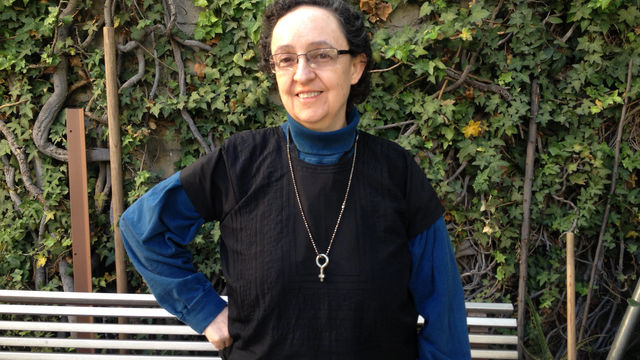
Mónica Mayer
Born in Mexico City in 1954, Mónica Mayer studied at the Escuela Nacional de Artes Plásticas of the Universidad Nacional Autónoma de México (formerly the Academia de San Carlos) between 1972 and 1976. She quickly realized how her female identity adversely impacted the reception of her work. Following debates engendered by the United Nations International Women's Year and its main conference, held in Mexico City in 1975, Mayer became involved in the feminist group Movimiento Feminista Mexicano and the feminist film collective Colectivo Cine Mujer. In her first exhibitions, Collage íntimo (1977) and Muestra colectiva feminista (1978), she showed drawings and collages, mediums that would remain the mainstay of her production. In 1978 at the biennial exhibition Salón 77–78: Nuevas tendencias at the Museo de Arte Moderno in Mexico City, she presented a participatory installation, El tendedero (The clothesline), which established the tenets of future projects: it was designed for a specific public event and solicited responses and engagement from the audience.
Between 1978 and 1980 Mayer studied at the Feminist Studio Workshop at the Woman's Building in Los Angeles with such key figures of the feminist art movement as Suzanne Lacy (b. 1945) and Leslie Labowitz (b. 1946). In 1980 she obtained a master's degree in the sociology of art from Goddard College with the thesis "Feminist Art: An Effective Political Tool." On her return to Mexico, Mayer began meeting with women artists to discuss and probe the possibilities of feminist art. In 1983 she cofounded the group Polvo de Gallina Negra with Maris Bustamante (b. 1949) and, initially, Herminia Dosal. The first consciously proclaimed feminist art collective in Mexico, it was active until 1993. In 1989 Mayer and her husband, Víctor Lerma (b. 1949), cofounded Pinto mi Raya, which after a three-year run as an independent arts space became a platform for the development of "projects of applied conceptual art" that aim to "lubricate the art system so that it works better."#
As an extension of her artistic practice, Mayer has spoken and written extensively about art, women, and feminism. Between 1988 and 2008 she was a columnist for the daily newspaper El Universal. She has published several books—most notably Rosa chillante: Mujeres y performance en México (2004)—and multiple essays, both in Mexico and abroad, and has contributed to such journals as Poliéster, Curare, Debate Feminista, n.paradoxa, and Performance Research and to books, including Perform, Repeat, Record: Live Art in History (2012), edited by Amelia Jones and Adrian Heathfield.
—Dorota Bizcel
Selected Performances, Actions, and Solo Exhibitions
1978 Lo normal, Casa de la Juventud, Colonia Guadalupe Tepeyac
1979–80 Traducciones: Un diálogo internacional de mujeres artistas, Mexico City, Cuernavaca, and Oaxaca
1995 Justicia y democracia, Museo de Arte Moderno, Mexico City (with Víctor Lerma)
2013–14 Archiva: Obras maestras del arte feminista en México, Encuentro Feminista, Guadalajara, Mexico
2016 Mónica Mayer: Si tiene dudas . . . pregunte; Una exposición retrocolectiva, Museo Universitario Arte Contemporáneo, UNAM, Mexico City
Selected Bibliography
Mayer, Mónica. "Propuesta para un arte feminista en México." Fem 9 (April–May 1984): 12–15.
Mónica Mayer: Novela rosa, o, me agarró el arquetipo. Mexico City: Museo de Arte Carrillo Gil, 1987.
Mónica Mayer: Si tiene dudas… pregunte; Una exposición retrocolectiva. Mexico City: Museo Universitario Arte Contemporáneo, 2016.
Quiles, Daniel. "Mónica Mayer." Artforum 54 (May 2016): 352–53.


